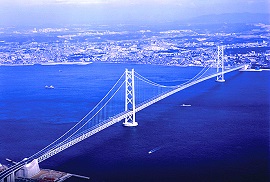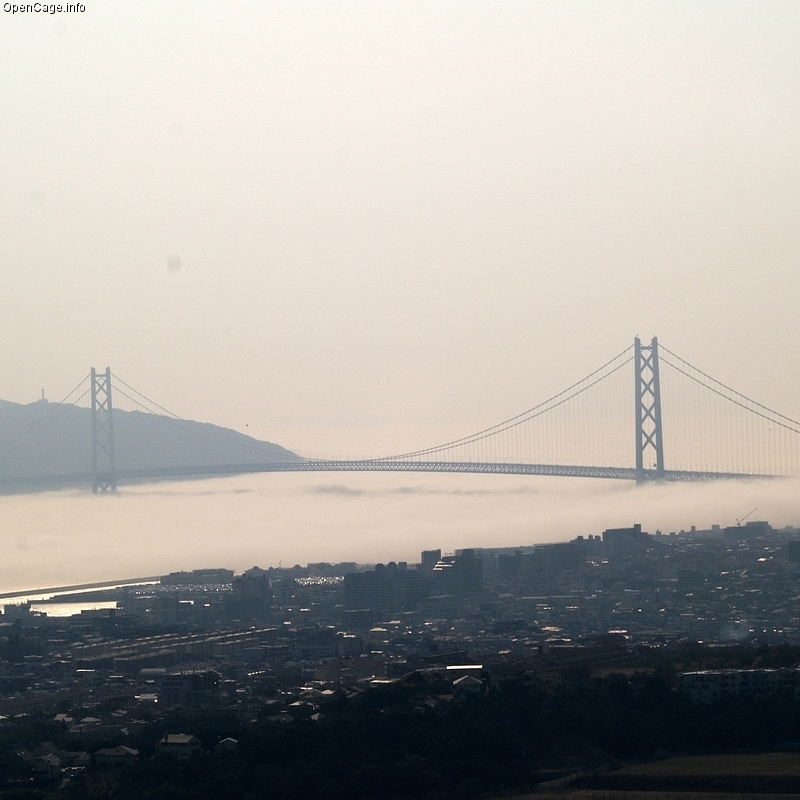Akashi Kaikyo Bridge
Contents |
[edit] Introduction
Completed in 1998, the Akashi Kaikyo is a 3.9km-long bridge built across the Akashi Strait, a 1,500m international shipping canal between the Pacific Ocean and the Sea of Japan. The suspension bridge connects the city of Kobe (mainland of Honshu) to Iwaya (Awaji Island) in Japan. The spectacular view of the bridge at night resulted in the name, Pearl Bridge.
The bridge was opened to traffic on 5 April 1998. It forms part of the Honshu-Shikoku Highway. The original design of the bridge was prepared for both cars and trains. Later, the final design was approved only for the roadway. The bridge carries nearly 23,000 cars each day.
Research had revealed the need for implementing new technology and maintenance techniques for proper management and maintenance of the bridge. A dry air injection system was one of the technologies used to maintain the bridge.
[edit] Resistant design
The two strong girder system enables the structure of the bridge to withstand typhoons of 180mph, earthquakes up to magnitudes of 8.5 on the Richter scale and harsh sea currents.
The foundation of the tower-pier was designed to transmit 181,400mt of vertical force to the rock layer, which is about 60m below the surface of the water. The bridge employs pendulums, which operate at the resonance frequency of the bridge to dampen forces.
Underwater non-disintegration concrete was developed for the bridge's construction for better fluidity and consistency.
[edit] Construction
It has six lanes of roadway, three in each direction. It consists of three spans. The length of the central span is 1,991m, currently (2016) the longest span for a suspension bridge. The end spans are 960m long each. The truss width is 35m. The bridge is located at a height of 280m from the sea level.The height of each supporting pylon is 282.8m (928ft). In a day, the bridge can expand up to two metres (seven feet) due to heat.
The bridge is illuminated with a total of 1,737 lights which include 1,084 on the main cables, 116 on the main towers, 404 on the girders and 132 on the anchorages. Three high light discharge tubes of red, green and blue colours were set up on the main cables.
Construction began in May 1988 and took nearly ten years to complete. The foundation depth of the bridge is equivalent to that of a 20-storey apartment. Nearly 181,000t of steel and 1.4 million cubic metres of concrete were used in the construction of the bridge.
More than 100 contractors were involved in the construction of the bridge. The main contractor was Honshu Shikoku Bridge Authority.
[edit] Finances
The total cost incurred of the bridge was $4.3bn. The cost was endured by the Honshu Shikoku Bridge Authority. The high cost of construction was due to the seismic design elements that had to be incorporated.
[edit] Related articles on Designing Buildings Wiki
Featured articles and news
Latest Build UK Building Safety Regime explainer published
Key elements in one short, now updated document.
UKGBC launch the UK Climate Resilience Roadmap
First guidance of its kind on direct climate impacts for the built environment and how it can adapt.
CLC Health, Safety and Wellbeing Strategy 2025
Launched by the Minister for Industry to look at fatalities on site, improving mental health and other issues.
One of the most impressive Victorian architects. Book review.
Common Assessment Standard now with building safety
New CAS update now includes mandatory building safety questions.
RTPI leader to become new CIOB Chief Executive Officer
Dr Victoria Hills MRTPI, FICE to take over after Caroline Gumble’s departure.
Social and affordable housing, a long term plan for delivery
The “Delivering a Decade of Renewal for Social and Affordable Housing” strategy sets out future path.
A change to adoptive architecture
Effects of global weather warming on architectural detailing, material choice and human interaction.
The proposed publicly owned and backed subsidiary of Homes England, to facilitate new homes.
How big is the problem and what can we do to mitigate the effects?
Overheating guidance and tools for building designers
A number of cool guides to help with the heat.
The UK's Modern Industrial Strategy: A 10 year plan
Previous consultation criticism, current key elements and general support with some persisting reservations.
Building Safety Regulator reforms
New roles, new staff and a new fast track service pave the way for a single construction regulator.
Architectural Technologist CPDs and Communications
CIAT CPD… and how you can do it!
Cooling centres and cool spaces
Managing extreme heat in cities by directing the public to places for heat stress relief and water sources.
Winter gardens: A brief history and warm variations
Extending the season with glass in different forms and terms.
Restoring Great Yarmouth's Winter Gardens
Transforming one of the least sustainable constructions imaginable.
























